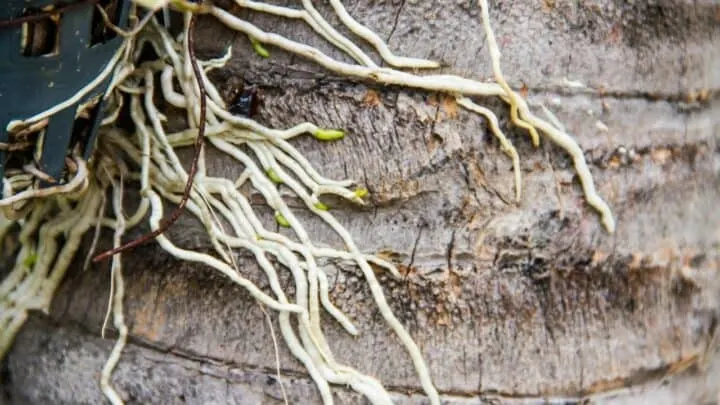Lovely additions to your home, orchids come in various colors with blooms that range from very simple and delicate to those that are grand.
Expensive to purchase, you can expand your collection by rooting broken pieces of your plant or clipping pieces of it and learning how to root an orchid.
You can grow orchids from seed, but the process takes weeks.
In addition, once you have a sprouted orchid, it will take several years before blooms are produced.
Rooting an orchid (vegetative propagation) is more straightforward than starting a plant from a seed.
Read below to learn how to root an orchid, and you will have a few more of yourself and some to give away.
Table of Contents
How to root an orchid
First, find a stem at least 10 inches long (25.4cm) with a sound root system. Cut it near the base, just above the leaf node. Then, cut into smaller pieces with 2 nodes per section. Place them in a tray of damp sphagnum moss under indirect sunlight. Spritz for moisture occasionally, and in 30 days or so, you’ll have new orchids.
Rooting Orchids From Offshoots
Stem cuttings are not the only way to expand your orchid collection.
Using offshoots is the easiest way to propagate your orchids. Not all orchids have offshoots, however.
If you are lucky enough to have orchids that do, you can quickly expand your orchid collection.
Often referred to as Keiki (baby in Hawaiian), offshoots of an orchid are small plants that form at the base of the plant or form off of a stem.
They should not be cut until the host plant has bloomed.
Varieties of orchids that produce offshoots include Phalaenopsis, Epidendrum (sensu lato), and Dendrobium varieties of orchids.
That is not to say that other orchids will not have nodes; it is just that these varieties will produce them.
How To Root Orchid Offshoots
Since orchid offshoots develop roots along the stem, your offshoot can be potted up once you free it from the parent plant.
They can then be placed in a six-inch pot that is filled with sphagnum moss.
After potting your orchid, the plant should be placed in a dark corner of your greenhouse. Wherever you put it, leave it alone, except for a light spritzing of water until it forms roots.
After a few weeks, the orchid will be strong enough to join your other plants in the sunshine.
First, however, do not place your newly potted plants in direct sunlight.
For the first few days, allow them only filtered light. Then, after a week or so, they can be moved further into the sunlight until they are fully acclimated.
Other Ways To Propagate Orchids
Root division is another method for propagation. It requires a mature plant that has overgrown its container and knows how to cut each plant free from the other.
Older plants will often overgrow the vessel they live in, and you will need to repot it.
Repotting gives you a perfect opportunity to divide the roots and have more plants to add to your collection of orchids.
When dividing an orchid, you can use either active or inactive pseudobulbs. A pseudobulb that is active, also called a division, has stems and leaves.
They can be divided if there is the orchid has enough root system to support it. Cut them free of the mass of roots and pot them up in a bed of sphagnum moss.
For dormant pseudobulbs, called back bulbs, which are those with no stems or seeds, can be gently divided and planted.
In a short time, you will have new plants that will eventually produce a gorgeous flower.
About Back Bulbs
Back bulbs do not show active growth, as do pseudobulbs, as they are the old pseudobulbs.
However, it’s possible to revive them if they have a dormant eye or two.
You may be able to force a back bulb into growing.
For example, you can divide the bulbs by cutting the rhizome or rootstock, and you will end up with a division and a couple of back bulbs.
All three can be planted in sphagnum moss and should be misted daily until their roots take hold. DO NOT water them until they have formed roots.
About Orchid Planting Medium
As you journey through learning about orchids, you will come across terms like orchid rock and sphagnum moss.
Orchid mix components are materials that many of us are not accustomed to working with, except as an addition to the soil mix.
Each type of orchid you grow has specific needs.
For example, some orchids are terrestrial; they like earth, while epiphytic orchids are tree dwellers.
Some orchids will need to be grown in a medium like sphagnum moss, coconut husk, fir bark, perlite, or tree fern fibers.
Some plants like but one of these materials and others will like a blend.
Time, experience, and researching what others are doing with orchids will help you develop various lovely orchids.
Frequently Asked Questions About How To Root Orchids
Can an orchid be grown in water alone?
You can grow an orchid in water because almost all plants can be grown through hydroponics. Plants require certain nutrients and do not care where they get them as long as they receive them.
Are orchids hard to grow?
More than anything, orchids require patience to grow. A new plant may not bloom for two to three years after it is started.

Daniel has been a plant enthusiast for over 20 years. He owns hundreds of houseplants and prepares for the chili growing seasons yearly with great anticipation. His favorite plants are plant species in the Araceae family, such as Monstera, Philodendron, and Anthurium. He also loves gardening and is growing hot peppers, tomatoes, and many more vegetables.


